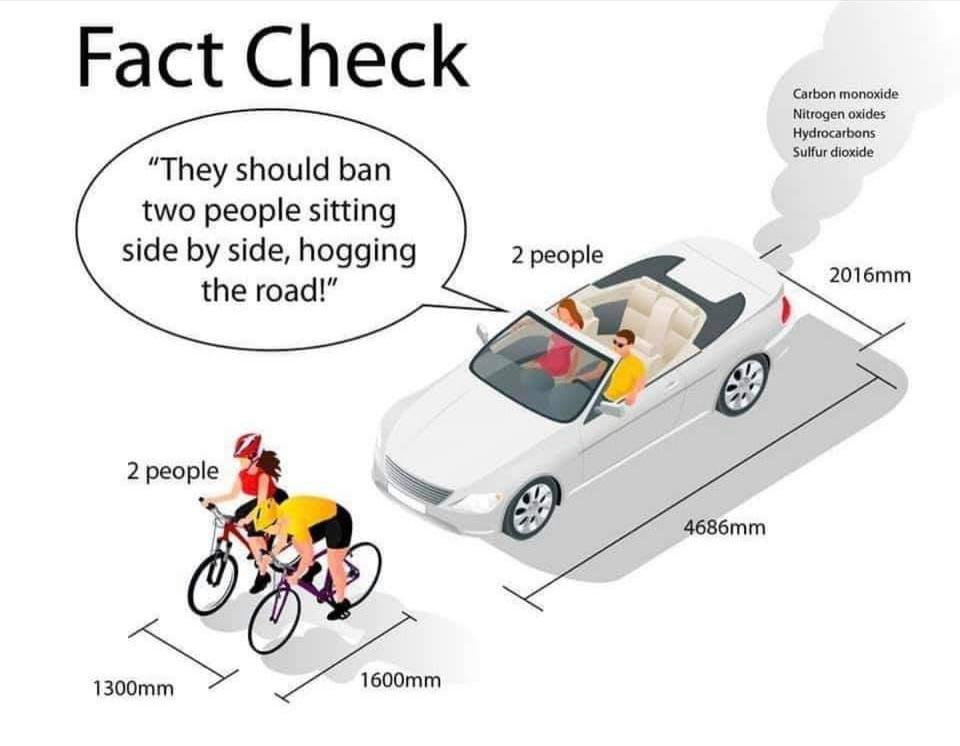Fuck Cars
A place to discuss problems of car centric infrastructure or how it hurts us all. Let's explore the bad world of Cars!
Rules
1. Be Civil
You may not agree on ideas, but please do not be needlessly rude or insulting to other people in this community.
2. No hate speech
Don't discriminate or disparage people on the basis of sex, gender, race, ethnicity, nationality, religion, or sexuality.
3. Don't harass people
Don't follow people you disagree with into multiple threads or into PMs to insult, disparage, or otherwise attack them. And certainly don't doxx any non-public figures.
4. Stay on topic
This community is about cars, their externalities in society, car-dependency, and solutions to these.
5. No reposts
Do not repost content that has already been posted in this community.
Moderator discretion will be used to judge reports with regard to the above rules.
Posting Guidelines
In the absence of a flair system on lemmy yet, let’s try to make it easier to scan through posts by type in here by using tags:
- [meta] for discussions/suggestions about this community itself
- [article] for news articles
- [blog] for any blog-style content
- [video] for video resources
- [academic] for academic studies and sources
- [discussion] for text post questions, rants, and/or discussions
- [meme] for memes
- [image] for any non-meme images
- [misc] for anything that doesn’t fall cleanly into any of the other categories
Recommended communities:
view the rest of the comments

A car takes up at least the width of two bikes by default. Why do they have the right to do that while bikes don't?
Maybe we should focus more on overall efficiency and sustainability of our transport systems, and by that metric, cars shouldn't even exist. A four lane road takes up the same width as a two track rail corridor and mixed use pedesterian/bike paths on either side, but can transport far more people per hour than private cars while being both cheaper in the long run and more environmentally friendly.
Because they can move fast enough to not be in the way for people behind them, since they are among the fastest vehicles on our roads. Bikes are considerably slower, which makes it more of a nuisance for those they're sharing the road with if they can't easily be passed.
Bike lanes are a good thing, and being courteous is a good thing- that goes both for passing when safe and being respectful of bike riders when you're driving a car, and also for allowing cars to pass where possible when you're moving significantly slower than the average traffic speed on a bicycle. It doesn't have to be adversarial.
Trains are even faster than cars despite being more efficient. Cars actually get in the way of trains, as level crossings are among the worst bottlenecks to both speed and frequency on a railroad, even if every single driver obeys the rules perfectly, the existence of an intersection between two fundamentally incompatible modes of transport introduces a conflict point which inevitably creates inefficiencies. In this way, cars are a "nuisance" to trains in the same way bikes are to cars, and being courteous won't solve that. So by your own logic, we should get rid of cars and build rail instead.
It's far easier, cheaper, faster, and more space efficient to build a pedestrian or bike over/underpass than one for cars. A pedestrian overbridge is usually a community project with city involvement, a car overbridge is at the very least a city/country project potentially with state or federal funding.
Being courteous does solve that...? First off, trains don't share the road, they follow tracks, so thats somewhat of a convoluted comparison. But more importantly, you stop at train crossings so the train can go first...? Is your argument that that's inefficient? Everything is inefficient. Any solution to a really complicated problem like how multiple forms of transportation co-exist is going to have inefficiencies
Also, no idea where you got the idea that I would be opposed to building more rail and less cars? Cars should increasingly be de-prioritzed in favor of bikes, ebikes, and public transit, but bike riders should be courteous of those who are driving and vice versa, and cars should continue to stop at train tracks to allow trains to go by. Where on earth did you get the idea that my logic of "be considerate of those who are using a different means of transportation" means cars should go away or that cars shouldn't go away? Also we definitely should be building rail, if we're gonna deprioritze cars we need public transportation to help fill that gap for people who aren't in a position to commute or travel by bike/ebike, but all of our infrastructure is currently built around cars, and even in a distant future there will be a need for cars in addition to bikes and trains, we just have way too many of them
I don't mean to come across as rude, but your response to my comment honestly does really confuse me.
Be respectful of those you share the road with. That means driving in a way that's safe for cyclists. That means letting cars go by (when safe to do so) when you're cycling since they travel much faster than you. And definitely stop at train tracks so that trains can go by.